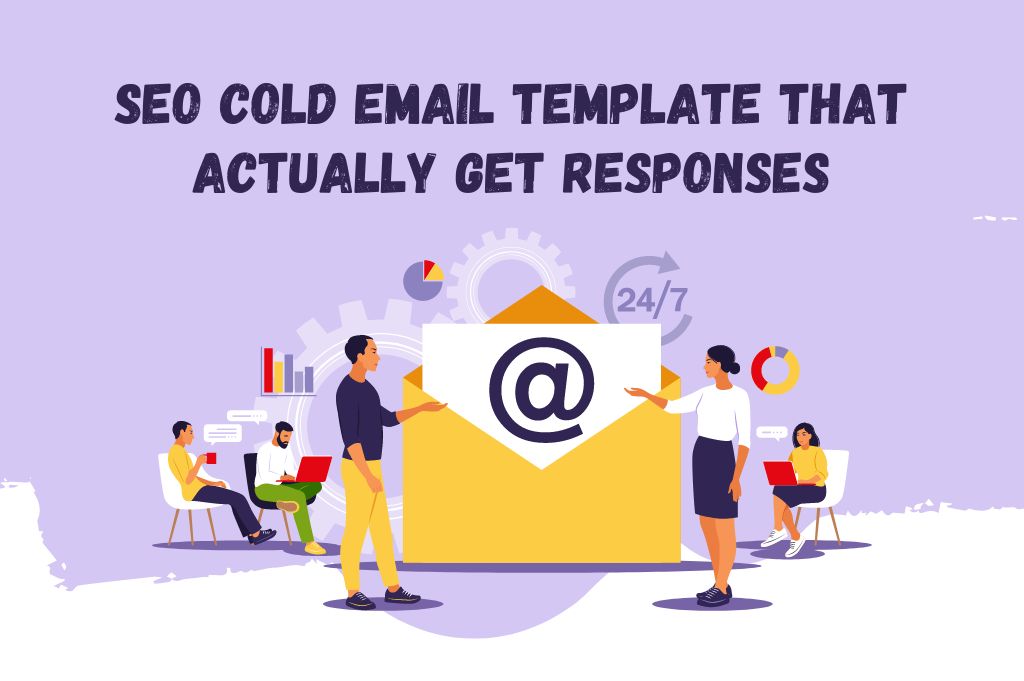Cold emailing is an effective method and powerful tool for reaching out potential clients, partners, or influencers. However, crafting an email that stands out in a crowded inbox and prompts a positive response requires skill and strategy.
This comprehensive guide explores the purpose of cold emailing, particularly for SEO professionals, and provides actionable templates to help you get responses and grow your business.
What is Cold Emailing?
Cold emailing is the best practice of sending unwanted emails to individuals or businesses with whom you have no prior relationship. Unlike spam, which is indiscriminate and often irrelevant, cold emails are targeted and personalized to the recipient’s needs and interests. The goal is to initiate a conversation, building a strong relationship, and achieve a specific objective, such as securing a meeting, making a sale, or gaining a backlink.
When done correctly, Cold emailing can be an effective way to generate leads, build professional connections, and grow your business. It requires a thoughtful approach, including thorough research, personalization, and a clear call to action.
Check Out Our Backlink Services
Before starting with the details of preparing effective cold emails, it’s worth noting that one of the primary uses of cold emailing in the SEO industry is to acquire backlinks. Backlinks are critical for improving your website’s search engine ranking and driving organic traffic.
If you’re looking to enhance your SEO strategy with high-quality backlinks, check out our comprehensive SEO backlinks service. We offer effective solutions to help you build a robust backlink profile and achieve your SEO goals.
What to Avoid In a Cold Email
Many cold emails fail because they fall into common traps that make them ineffective or even counterproductive. Here are some key mistakes to avoid:
- Lack of Personalization: Sending a generic email that could apply to anyone is a surefire way to get ignored. Personalization shows that you’ve done your homework and are genuinely interested in the recipient.
- Being Too Salesy: An overly aggressive sales pitch can be off-putting. Your initial email should focus on building a connection and providing value, rather than pushing for an immediate sale.
- Long and Rambling: People’s attention spans are short, especially when it comes to emails from strangers. Keep your message concise and to the point.
- Poor Subject Lines: The subject line is the first thing the recipient sees. If it’s not compelling, your email may never get opened.
- Lack of Clear Call to Action: If your email doesn’t clearly state what you want the recipient to do, they’re unlikely to take any action.
- Ignoring Follow-Ups: Not following up on your initial email is a missed opportunity. Sometimes it takes multiple touchpoints to get a response.
Tips for Writing Effective Cold Emails
Writing an effective cold email involves several key elements. Let’s break down each component to help you craft messages that get results.
1. Personalization
Personalization is crucial for making your email stand out and showing the recipient that you’re genuinely interested in them. Here are some tips for effective personalization:
- Research the Recipient: Find out as much as you can about the person or business you’re emailing. Look at their website, social media profiles, and recent news or blog posts.
- Use Their Name: Address the recipient by their first name to create a personal connection.
- Mention Specific Details: Reference something specific about their work, such as a recent project, blog post, or achievement.
2. Headers and Subject Lines
The subject line is arguably the most important part of your email. It’s the first thing the recipient sees and determines whether they’ll open your email. Here are some tips for crafting compelling subject lines:
- Keep It Short: Aim for 5-7 words or 50 characters. Shorter subject lines are more likely to be read.
- Create Curiosity: Pique the recipient’s curiosity to encourage them to open the email.
- Be Clear: Make it clear what the email is about. Avoid vague or misleading subject lines.
- Personalize It: Including the recipient’s name or a specific detail can increase open rates.
Examples:
- “Quick Question, [Recipient’s Name]”
- “Loved Your Post on [Topic]!”
- “Collaboration Opportunity for [Recipient’s Company]”
3. Content and Length
The body of your email should be concise, clear, and focused on the recipient. Here are some key points to consider:
- Keep It Short: Aim for 3-5 short paragraphs. The entire email should fit within a single screen.
- Focus on Them: Make the email about the recipient, not you. Highlight how you can provide value to them.
- Be Clear and Direct: State your purpose clearly and concisely. Avoid jargon and unnecessary details.
- Include a Call to Action: Clearly state what you want the recipient to do next, whether it’s scheduling a call, replying to the email, or visiting a link.
4. Make it About Them
One of the most common mistakes in cold emailing is making the email all about you and your product or service. Instead, focus on the recipient and their needs. Here are some ways to do that:
- Identify Their Pain Points: Show that you understand their challenges and offer a solution.
- Highlight Benefits: Explain how they will benefit from what you’re offering, rather than just listing features.
- Provide Value: Offer something valuable, such as a useful resource, insightful feedback, or a relevant case study.
5. Provide Proof of Yourself
Building trust is crucial in cold emailing. Providing proof of your credibility and expertise can help establish trust, credibility and increase your chances of getting a response. Here are some ways to do that:
- Share Testimonials: Include quotes or links to testimonials from satisfied clients.
- Mention Notable Clients: If you’ve worked with well-known companies, mention them.
- Include Case Studies: Provide brief case studies that highlight your success in solving similar problems.
- Link to Your Website: Include a link to your website or portfolio where they can learn more about you.
6. Following Up
Following up is a critical part of the cold emailing process. Many responses come from follow-up emails rather than the initial email. Here are some tips for effective follow-ups:
- Be Persistent but Polite: Follow up 2-3 times, spaced a few days apart. Keep the tone polite and respectful.
- Provide Value: In each follow-up, offer additional value, such as new insights or resources.
- Change the Angle: If the initial email didn’t get a response, try approaching the topic from a different angle.
- Keep It Short: Follow-up emails should be even shorter than the initial email. A few sentences are often enough.
Using Cold Email Templates for SEO
Cold email templates can save you time and ensure consistency in your outreach efforts. Here are some templates tailored for SEO professionals to help you get started.
Cold Email Template for Getting SEO Clients
Subject Line: Quick Question, [Recipient’s Name]
Email Body:
Hi [Recipient’s Name],
I hope this email finds you well. My name is [Your Name], and I’m the founder of [Your Company], a digital marketing agency specializing in SEO.
I came across [Recipient’s Company] and was impressed by your [mention something specific, such as a recent blog post, product launch, or company achievement]. I wanted to reach out because I believe there may be an opportunity for us to work together to improve your online presence and drive more organic traffic to your site.
Here are a few ways we could help:
- Conducting a comprehensive SEO audit to identify opportunities for improvement
- Optimizing your website content to target high-value keywords
- Building high-quality backlinks to boost your rankings on search engine
Would you be open to a quick call to discuss this further? I can share some insights and specific strategies that could benefit [Recipient’s Company].
Looking forward to hearing from you.
Best regards,
[Your Name]
[Your Position]
[Your Company]
[Your Contact Information]
Cold Email Template for Link Building
Subject Line: Loved Your Post on [Topic]!
Email Body:
Hi [Recipient’s Name],
I recently read your article on [Topic] and found it incredibly insightful. As someone who is also passionate about [related topic], I wanted to reach out and connect.
I noticed that you mentioned [related subject] in your post. I recently published a comprehensive guide on [specific aspect], which provides in-depth information and practical tips. I think it could be a valuable addition to your article and provide additional value to your readers.
Here’s the link to the guide: [URL]
If you find it helpful, I’d be thrilled if you could consider including it in your post. I’m also open to any collaboration opportunities or further discussions on this topic.
Thank you for your time and consideration.
Best regards,
[Your Name]
[Your Position]
[Your Company]
[Your Contact Information]
Cold Email Template for Guest Posting
Subject Line: Guest Post Opportunity for [Recipient’s Blog]
Email Body:
Hi [Recipient’s Name],
My name is [Your Name], and I’m an SEO specialist with a passion for writing about [specific topic]. I’ve been following [Recipient’s Blog] for a while, and I’m particularly impressed by your recent article on [mention a specific article]. Your insights on [related topic] are spot-on!
I’m reaching out to see if you accept my guest posts on [Recipient’s Blog]. I have some unique ideas that I believe would resonate with your audience and provide valuable insights on [specific topic]. Here are a few topics I’m considering:
- [Topic Idea 1]
- [Topic Idea 2]
- [Topic Idea 3]
I can provide high-quality, well-researched content that’s tailored to your readers’ interests. If you’re open to it, I’d love to discuss this further and get your thoughts.
Thank you for considering my request. I look forward to the possibility of contributing to [Recipient’s Blog].
Best regards,
[Your Name]
[Your Position]
[Your Company]
[Your Contact Information]
Cold Email Template for Outreach to Influencers
Subject Line: Collaboration Opportunity with [Your Company]
Email Body:
Hi [Recipient’s Name],
I hope you’re doing well. My name is [Your Name], and I’m the [Your Position] at [Your Company]. We specialize in [briefly describe your services or products], and I’ve been following your work on [platform or blog].
I’m reaching out because I believe there’s a great opportunity for us to collaborate. Your expertise in [specific field] and our innovative approach to [related service or product] could create something truly impactful.
Would you be interested in discussing this further? I’d love to explore how we can work together to achieve mutual goals.
Thankyou for your time, and I look forward to your response.
Best regards,
[Your Name]
[Your Position]
[Your Company]
[Your Contact Information]
Cold Email Template for Reconnecting with Old Leads
Subject Line: Let’s Reconnect and Explore New Opportunities
Email Body:
Hi [Recipient’s Name],
I hope this message finds you well. It’s been a while since we last connected, and I wanted to reach out to see how things are going with [Recipient’s Company].
Since we last spoke, we’ve achieved some exciting results in [specific area], and I believe there may be new opportunities for us to collaborate and help [Recipient’s Company] achieve even greater success.
Would you be open to a brief call to catch up and discuss potential synergies?
Looking forward to reconnecting.
Best regards,
[Your Name]
[Your Position]
[Your Company]
[Your Contact Information]
Conclusion
Cold emailing can be a highly effective SEO strategy when done correctly. By avoiding common mistakes, personalizing your emails, and focusing on providing value, you can increase your chances of getting responses and achieving your goals. Use the provided templates as a starting point, and customize them to fit your unique voice and the needs of your recipients.
Remember, the solution to successful cold emailing is persistence and continuous improvement. Analyze your results, tweak your approach, and keep refining your strategy to achieve the best possible outcomes.







